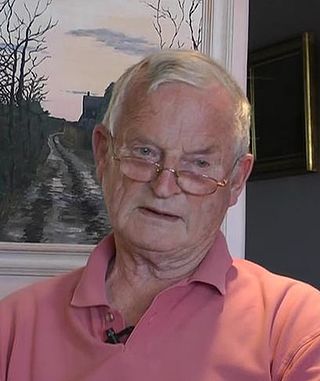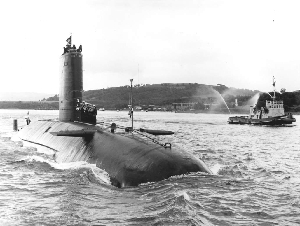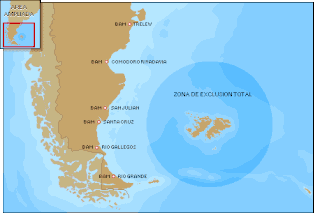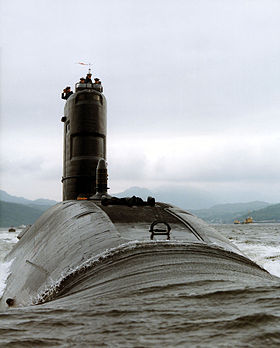
The Falklands War was a ten-week undeclared war between Argentina and the United Kingdom in 1982 over two British dependent territories in the South Atlantic: the Falkland Islands and its territorial dependency, South Georgia and the South Sandwich Islands. The conflict began on 2 April, when Argentina invaded and occupied the Falkland Islands, followed by the invasion of South Georgia the next day. On 5 April, the British government dispatched a naval task force to engage the Argentine Navy and Air Force before making an amphibious assault on the islands. The conflict lasted 74 days and ended with an Argentine surrender on 14 June, returning the islands to British control. In total, 649 Argentine military personnel, 255 British military personnel, and three Falkland Islanders were killed during the hostilities.

Admiral Sir John Forster "Sandy" Woodward, was a senior Royal Navy officer who commanded the Task Force of the Falklands War.

The Swiftsure class was a class of nuclear-powered fleet submarines in service with the Royal Navy from the early 1970s until 2010.

ARAGeneral Belgrano (C-4) was an Argentine Navy light cruiser in service from 1951 until 1982. Originally commissioned by the U.S. Navy as USS Phoenix, she saw action in the Pacific theatre of World War II before being sold to Argentina. The vessel was the second to have been named after the Argentine founding father Manuel Belgrano (1770–1820). The first vessel was a 7,069-ton armoured cruiser completed in 1896.

HMS Invincible was the Royal Navy's lead ship of her class of three light aircraft carriers. She was launched on 3 May 1977 as the seventh ship to carry the name. She was originally designated as an anti-submarine warfare carrier, but was used as an aircraft carrier during the Falklands War, when she was deployed with HMS Hermes. She took over as flagship of the British fleet when Hermes was sold to India. Invincible was also deployed in the Yugoslav Wars and the Iraq War. In 2005, she was decommissioned, and was eventually sold for scrap in February 2011.

HMS Splendid was a Royal Navy nuclear-powered fleet submarine of the Swiftsure class. From commissioning in 1979 to her decommission in 2004 she took part in many operations involving British forces around the globe.

HMS Conqueror was a British Churchill-class nuclear-powered fleet submarine which served in the Royal Navy from 1971 to 1990. She was the third submarine of her class, following the earlier Churchill and Courageous, that were all designed to face the Soviet threat at sea. She was built by Cammell Laird at Birkenhead.

HMS Sheffield was a Type 42 guided missile destroyer and the second Royal Navy ship to be named after the city of Sheffield in Yorkshire. Commissioned on 16 February 1975 the Sheffield was part of the Task Force 317 sent to the Falkland Islands during the Falklands War. She was struck and heavily damaged by an Exocet air-launched anti-ship missile from an Argentine Super Étendard aircraft on 4 May 1982 and foundered while under tow on 10 May 1982.
This article describes the composition and actions of the Argentine naval forces in the Falklands War. For a list of naval forces from the United Kingdom, see British naval forces in the Falklands War.

ARA Veinticinco de Mayo (V-2) was an aircraft carrier in the Argentine Navy from 1969 to 1997. The English translation of the name is Twenty-fifth of May, which is the date of Argentina's May Revolution in 1810.

An anti-submarine warfare carrier is a type of small aircraft carrier whose primary role is as the nucleus of an anti-submarine warfare hunter-killer group. This type of ship came into existence during the Cold War as a development of the escort carriers used in the ASW role in the North Atlantic during World War II.
Operation Journeyman was a Royal Navy operation in which a naval taskforce was secretly sent to the Falkland Islands in November 1977 to prevent an Argentine invasion.

Admiral of the Fleet John David Elliott Fieldhouse, Baron Fieldhouse, was a Royal Navy officer. He commanded five submarines and a frigate before achieving higher command from the 1970s. Following the invasion of the Falkland Islands by Argentine forces in April 1982, Fieldhouse was appointed Commander of the Task Force given responsibility for "Operation Corporate", the mission to recover the Falkland Islands. The campaign ended in the surrender of Argentine forces in June 1982. He became First Sea Lord and Chief of Naval Staff in December that year and, in that role, persuaded the British Government to fund the replacement of ships lost in the Falklands War. He went on to be Chief of the Defence Staff from 1985 until his retirement in 1988.
These are some of the key weapons of the Falklands War used by both sides.

Operation Paraquet was the code name for the British military operation to recapture the island of South Georgia from Argentine military control in April 1982 at the start of the Falklands War.
There were many events leading to the 1982 Falklands War between the United Kingdom and Argentina over possession of the Falkland Islands and South Georgia.

The Total Exclusion Zone (TEZ) was an area declared by the United Kingdom on 30 April 1982 covering a circle of radius 200 nautical miles from the centre of the Falkland Islands. During the Falklands War any sea vessel or aircraft from any country entering the zone was liable to be fired upon without further warning.

The aftermath of the 1982 Falklands War between the United Kingdom and Argentina affected world geopolitics, the local political culture in Argentina and the UK, military thought, medical treatment, and the lives of those who were directly involved in the war.

ARA Granville (P-33) is a Drummond-class corvette of the Argentine Navy named after Guillermo Enrique Granville, who fought in the 1827 Battle of Juncal against Brazil.

Exercise Spring Train was an annual Royal Navy-led NATO maritime exercise conducted in the Eastern Atlantic. It is most notable for the 1982 exercise which involved seven warships that were subsequently sent to the South Atlantic after the Argentine invasion of the Falkland Islands. Because the vessels involved already had full crews and were able to crossdeck supplies from other ships in the exercise the British response was more rapid than would have otherwise been possible. Two of the vessels involved in the exercise, the Type 42 destroyers Sheffield and Coventry, were sunk during the war. There has been speculation that some of the ships sent to the Falklands from Exercise Spring Train were carrying tactical nuclear weapons, which were routinely carried when on NATO deployments. The 1983 edition of the exercise was criticised by the Spanish and Soviet government who considered it provocative.
















